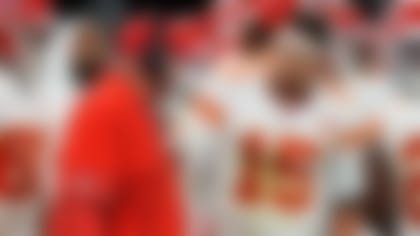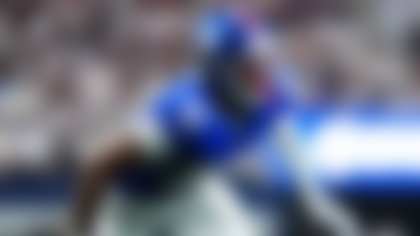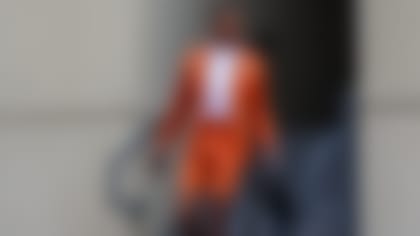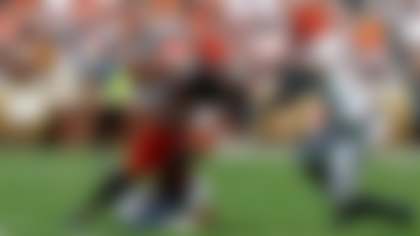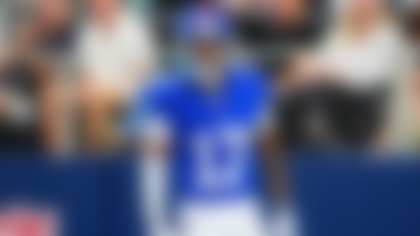INDIANAPOLIS -- The 2020 NFL Scouting Combine began in earnest on Thursday, with quarterbacks, receivers and tight ends performing their on-field workouts at Lucas Oil Stadium in Indianapolis.
The vast majority of young men at the combine perform as expected. A few "winners" exceed those expectations, though, or at least meet the very high expectations placed on them coming into the event. A strong combine is unlikely to push a Day 3 prospect into the first round, but it can allow him to win tiebreakers over other similarly valued players at his position.
Unfortunately, others fail to change scouts' minds about deficiencies keeping them from being at the top of the class. Thankfully for those players, the combine is only one part of a robust evaluation process. Teams will add the workout data from Indy to the prospects' game tape, all-star game performances, interviews and background checks to determine their final grade.
Winners
Justin Herbert, QB, Oregon: Nothing surprising about Herbert's athleticism or his throwing prowess Thursday night. The ball came out very well and the placement was plus. The arc on his deep throws was impressive. Receivers didn't have to work too hard to bring in his passes, whether on in-routes or speed outs. The Oregon product was also smiling and joking during the workout, showing plenty of personality. Yes, everything was against air, but I've seen other talented passers look far less polished in the same situation. Mission accomplished.
Harrison Bryant, TE, Florida Atlantic: Bryant not only ran well (4.73 40), but he was the most consistently smooth mover during the various position drills, just besting Dayton's Adam Trautman (4.80 40, 6.78 three-cone) for this spot. He adjusted to throws all around him, snatching the ball with strong hands, while also moving quickly around cones with impressive footwork. Bryant also was one of the few tight ends to push the blocking sled, staying low and moving his feet while others pushed the sled upward and failed to generate movement.
Aaron Fuller, WR, Washington: Fuller's lack of size (5-foot-11) and below-average 40 time (4.59) mean little to me. The former Husky was the most natural hands-catcher in the first group of receivers. While not huge or extremely fast, his route-running was quick and reliable. I don't know how high Fuller will be drafted, but he'll likely still be waiting to go long after his quarterback has heard his name called. Teams willing to overlook his measurables and rely more on his game tape and combine performance, however, should take a shot on his talent.
John Hightower, WR, Boise State: After posting testing results that were among the best in his group (4.43 40, 1.49 10-yard split, 38.5-inch vertical), Hightower caught the ball well in drills. He displayed a nice catch radius, snatching high passes out of the air smoothly on multiple occasions. Teams looking to find a potential playmaker in the vertical game late on Day 2 of the draft should have been paying attention.
CeeDee Lamb, WR, Oklahoma: The competition between the top three receivers in the class (Lamb, Jerry Jeudy and Henry Ruggs III) remained tight after Thursday's workout. Lamb won out with the catch of the night, displaying his elite body control and superb hands to stretch for a high, hot pass on the sideline, keeping his feet in-bounds. The other receivers shouted in approval after the grab. Jeudy also had a nice night, besting Lamb slightly in the 40 (4.45 vs. 4.50) and showing off his elite agility and late hands to snatch the ball from the air. The final member of the top-notch triumvirate, Jeudy's Tide teammate Ruggs, had to ice his quad after his combine-best sub-4.3 40-yard dashes, sitting out the rest of the night. That helped Lamb's circus catch make a final, lasting impression to add to his solid overall evening -- giving him the crown as the best of the trio.
Quez Watkins, WR, Southern Miss: Watkins made headlines with a 4.35 40, but that's not the primary reason I included him on this list. Effortless movement in drills and smooth hands on catches made him a standout among the first group of receivers. The underclassman entrant did not get much pub while starring in Conference USA the past two seasons. Scouts noted his all-around effort on Thursday, though -- he's likely to have clinched a top-150 spot with his performance and on-field production. The ultimate test for Watkins (and the other receivers listed here) will be trying to get off physical coverage at the next level, something he didn't have to do on Thursday.
Losers
Jake Fromm, QB, Georgia: There were no major surprises with Fromm's mostly average measurements earlier this week (despite the chatter about his hand size). His arm strength during workouts was also adequate, as expected. However, his throws fluttered at times, and his deeper tosses were not as strong as those of Herbert and Washington's Jacob Eason. When he tried to push his arm past its limits, the ball came out poorly. Again, none of this was shocking to anyone who watched Fromm play live at Georgia. Unfortunately, these deficiencies were exacerbated by the side-by-side comparison with the other well-known quarterback prospects competing on Thursday night. Does this mean Fromm will fail in the NFL? Absolutely not. He is a guy I'd take on my team any day, and I suspect he'll have a solid career. However, his combine workout did not push him into the elite category of this QB class.
Jared Pinkney, TE, Vanderbilt: Pinkney put himself on NFL scouts' radars as a junior, but he saw his production drop in 2019. A strong combine may have pushed him into the top-150 conversation, but his workout did not go as well as planned. It started with the slowest 40-yard dash among the tight ends (4.96 seconds). Stiff movement and his struggles catching passes during drills also did not help his cause.
Laviska Shenault Jr., WR, Colorado: It was expected that Shenault would run in the 4.5s but he posted a time on the low end of the expected range (4.58 seconds) and then didn't run a second 40 or compete in any other drills. It's not yet clear if he suffered an injury during his run, but it was certainly not the showing he hoped for in a year that features an extremely deep pool of talent at his position. His 40 time is not bad at all for a 227-pound receiver, and I suspect it will improve at his pro day (40 times are usually better at pro days). Shenault's run-after-catch ability is among the class' best, and no workout can (or should) take that away from him. However, on this occasion, he was unable to close the gap on the top-end receivers in the class.
UPDATE: Per NFL Network Insider Ian Rapoport, Shenault will undergo surgery on Tuesday to repair a core muscle injury he dealt with during the 2019 season and the combine. His timetable for recovery is six to eight weeks, according to Rapoport.
Mitchell Wilcox, TE, South Florida: It was a tough day for Wilcox, who took a ball to the face during the gauntlet drill. To his credit, he vowed to bounce back from the "rough day at the office." But there's no denying he fought the ball while trying to secure several other catches during the workout, as well, seemingly losing confidence in his hands. Wilcox was not able to show above-average athleticism in drills with a 31-inch vertical and a 4.88 40. Teams going back to the tape will see a productive player, but Thursday was not his day.
UPDATE: Per NFL Network's Tom Pelissero, Wilcox popped a blood vessel in his left eye when the ball hit his face, likely impacting Wilcox's ability to perform during the rest of the workout.
Follow Chad Reuter on Twitter _@chadreuter_.

